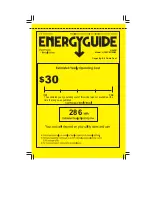
SUGGESTED ARRANGEMENT OF FOOD IN THE FRIDGE/FREEZER
Arrangement Examples (See diagram)
1. Baked, chilled cooked food,
dairy products, cans.
2. Meat, sausages, cold cuts.
3. Fruit, vegetables, salads.
4. Making, storing ice cubes.
5. Frozen food.
6. Frozen food and
freezing of fresh food.
7. Butter, cheese.
8. Small bottles, cans, tubes.
9. Eggs.
10. Tall, large bottles, beverages.
TEMPERATURE CONTROL AND ADJUSTMENT
Operating temperatures are controlled by the thermostat knob (see diagram) located
on the ceiling of fridge compartment. Settings may be made from 1 to 5, 5 being
the coldest position.
When the appliance is switched on for the first time, the thermostat should be
adjusted so that after 24 hours, the average fridge temperature is no higher than
+5°C (+41°F). We recommend you set the thermostat half way between the 1 and
5 setting and monitor to obtain the desired temperature i. e. towards 5 you will
obtain a colder fridge temperature and vice versa. Some sections of the fridge may
be cooler or warmer ( such as the salad crisper and the top part of the cabinet )
which is quite normal.
The normal storage temperature of the freezer should be -18°C (0°F). Lower
temperatures may be obtained by adjusting thermostat knob towards 5 position.
We recommend that you check the temperature with an accurate thermometer to
ensure that the storage compartments are kept to the desired temperature.
Remember you must take your reading very quickly since the thermometer
temperature will rise very rapidly after you remove it from the freezer.
Please remember each time the door is opened cold air escapes and the internal
temperature rises. Therefore never leave the door open and ensure it is closed
immediately after food is put in or removed.
In case of a temporary ice build up in the fridge compartment, reduce the
thermostat setting to 1, monitoring at the same time that the fridge temperature
is m5 degrees C [41 degrees F]. Once the ice build up disappears
and the appliance starts auto defrosting again as normal, then you may
increase the thermostat setting, if required.
When you set the thermostat knob to 0 [Zero] position, the appliance will be switched
off.
10
9
The following guidelines and recommendations are suggested to obtain the best
results and storage hygiene.
1. The fridge compartment is for the short term storage of fresh food and drinks.
2. The freezer compartment is
rated and suitable for the freezing and
storage of pre frozen food. The recommendation for
storage as
stated on the food packaging should be observed at all times.
3. Cooked dishes must be stored in airtight covered containers.
4. Fresh wrapped produce can be placed on the shelf. Fresh fruit and
vegetables should be cleaned and stored in the crisper bins.
5. Bottles can be placed in the door section.
6. To store raw meat, wrap in polythene bags and place on the lowest shelf. Do
not allow to come into contact with cooked food to avoid contamination. For
safety, only store raw meat for two to three days.
7. Keep the food packed wrapped or covered. Allow hot food and beverages to
cool before placing them in the fridge. Do not store explosive substances. High
proof alcohol must be stored upright in sealed containers. Left over canned
food should not be stored in the can.
8. Fizzy drinks should not be frozen and products such as flavoured water ices
should not be consumed too cold.
9. Some fruit and vegetables suffer damage if kept at temperatures near 0°C.
Therefore wrap pineapples, melons, cucumbers, tomatoes and similar produce
in polythene bags.
10. Place chilled cooked food and similar food near the rear of the fridge inner
liner where the cold wall is located.
11. Shelves, racks, crisper bins, drawers, flaps, bottle grippers are all removable.
12. Do not l
eave frozen food at room temperature to thaw; the best way to defrost
food is to put it in the fridge to thaw slowly. Make sure you avoid defrosting
food or food juices drip onto other food.
13.
For hygiene reasons, always wrap food using a suitable packaging material
before storing in your appliance to avoid contact with the appliance surface.
10
7
1
3
4
6
9
2
8
5





























